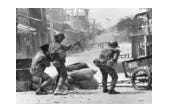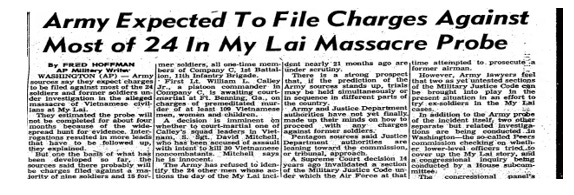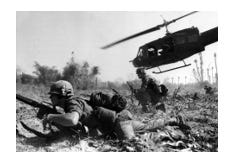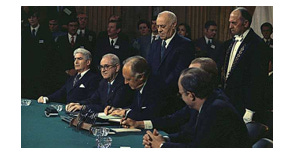The Forgotten War (November 2023)
Reuploaded from the Ama Duniya Magazine in November 2023 at age 17, unedited from back then.
By Ishaan Padhi, Age 17
When looking for what to write about for Ama Duniya, there are many ways to figure it out. For the first time, this topic regarding the Vietnam War was inspired by a Vietnam War Veteran who approached me while I was at a store marketplace area. I heard his story, which was honorable and inspiring for his message for Generation Z and beyond.
The Period before the American Intervention in Vietnam
Before the American Intervention in Vietnam began, the state of the world was between the United States and the Soviet Union. The Red Scare came with hysteria regarding the threat of the Soviet Union and communism. Reds is referred to as the color of the flag of the Soviet Union. The Cold War was also intensifying at the same time. In response to the Cold War heightening at the same time, President Dwight D. Eisenhower and the policy of the United States was to harden their position and policy against any ally of the Soviet Union, including North Vietnam. As a result, the United States pleaded its full support to South Vietnam, starting with training and equipment from the American Military and the CIA. South Vietnam used its resources to crack down on North Korean sympathizers. When John F. Kennedy became President, he and the United States Government started working and forming their policy on one theory that if one country in Southeast Asia fell to communism, other countries in Southeast Asia would follow suit.
This resulted in more U.S. aid but never committed to a large-scale military intervention. In 1962, the American Military presence in South Vietnam had reached 9,000 troops compared to fewer than 800 during the 1950s. In the period before American Intervention, the Vietnam War already started with North Vietnam wanting to unify the two countries into a country modeled on the People's Republic of China and the Soviet Union, while South Vietnam was based on a Vietnam that is aligned with the West. North Vietnam started the Vietnam War on November 1st, 1955. After the assassination of President John F. Kennedy in 1963, President Lyndon B. Johnson continued what JFK started but escalated the U.S. involvement in the war.
The Gulf of Tonkin and Operation Rolling Thunder
On August 2nd, 1964, North Vietnamese patrol torpedo boats attacked the U.S.S Maddox and U.S.S Turner Joy in the Gulf of Tonkin. Immediately, President Lyndon B. Johnson ordered a retaliatory bombing of military targets in North Vietnam. Congress also responded by passing the Gulf of Tonkin Resolution, giving President Lyndon B. Johnson broad war-making powers. Later, on March 2nd, 1965, Operation Rolling Thunder began, resulting in a bombing campaign being conducted in response to a Viet Cong (members of a communist guerrilla movement that fought South Vietnam with the support of the North Vietnamese Army) attack on a U.S. air base at Pleiku. The Johnson administration believed that heavy and sustained bombing could encourage North Vietnamese leaders to accept the non-Communist government in South Vietnam and intended to reduce the ability of North Vietnam to produce and transport supplies to aid the Viet Cong.
The arrival of U.S. ground troops in South Vietnam, the draft, and the consequences of the draft
On April 1st, 1965, President Lyndon B. Johnson committed the first U.S. ground troops to the Vietnam War; the original mission was to defend air bases in South Vietnam used for the bombing campaign, but later on, their roles were revised to engage the Viet Cong in active combat. Conscription, otherwise known as the draft, occurred during the 1960s under the peacetime draft using the authority of the Selective Training and Service Act of 1940, signed by FDR. Between 1954-1964, from the end of the Korean War to the escalation in Vietnam, the so-called "peacetime" draft inducted more than 1.4 million American Men, an average of more than 120,000 per year. In July 1965, President Lyndon B. Johnson announced the draft inductions would increase from 17,000 to 35,000 monthly. Officially, on December 1st, 1969, the first draft lottery since 1942 began. During the period of the Vietnam War and the draft, individuals like the Vietnam War Veteran I met were drafted. The Vietnam War Veteran I met told me that 3 of his brothers were drafted against their will, and then he was drafted into the war. Imagine this Veteran's position: 3 of his brothers were drafted to fight in a war they did not believe in, and he, too, was drafted.
It must have been a scary time in the period of American history. The draft being conducted also promoted the anti-war effort, with individuals doing what they could to avoid the draft, with legal or illegal means under the law at the time. One individual who fought the draft was Heavyweight champion boxer Muhammad Ali, who refused to be drafted into the U.S. Army and was convicted in Houston on June 20th, 1967, for refusing induction in the U.S. Armed Forces to 5 years in federal prison and a $10,000 fine, which is the maximum penalty. Muhammed Ali vowed to appeal the conviction, which went all way to the U.S Supreme Court, known as Clay v. United States, 403 U.S. 698 (1971), and on June 28th, 1971, Muhammed Ali's Conviction was overturned with unanimous verdict on the grounds of a technical error by the Justice Department, initially, the remaining eight Justices (Justice Thurgood Marshall recused himself due to him being U.S Solicitor General when the case began) voted 5 to 3 to uphold the conviction, but Justice John Marshall Harlan II, who was assigned to write the majority opinion became convinced that Ali's claim to be a conscientious objector was sincere after reading background material on Black Muslim doctrine provided by one of his law clerks, this led to Justice Harland changing his vote due to the claim by the Justice Department being a misrepresentation, to 4-4, a deadlock which would had resulted in Muhammed Ali being jailed for draft evasion and no opinion being written, which Ali would never had known why he lost.
Justice Potter Stewart proposed a compromise that was agreed upon by the 8 Justices. A quote from the case by Eugene Register-Guard states, "The Boxer's beliefs are 'surely no less religious-based than in those previous cases'" and Incorporated Welsh V. United States, in which the Court had ruled that "moral and ethical objection to war was as valid as religious objection, thus broadening the qualifications." The people were heavily against the draft, which fueled the anti-war sentiment against the Vietnam War. Over 1.9 million service personnel were conscripted throughout the Vietnam War. Draft lotteries starting in 1969 were conducted on birth dates and were televised events watched by millions of Americans. The draft was finally ended in 1973. One unfortunate consequence of the draft was that U.S. soldiers who finished their service in Vietnam had to hide the fact that they served in the Vietnam War, including the Veteran that I met, due to the extreme anti-war sentiments and that Vietnam War Veterans were attacked and berated on all fronts, even though they had to serve against their own will. Decades later, everyone in the United States began to respect and honor Vietnam War Veterans.
Imagine being sent against your will and surviving, only to return to your people berating and attacking you for your service that you did not consent to. It was an agitated and scary time.
The Vietnam War During American Intervention
The Tet Offensive
The Tet Offensive was a coordinated series of North Vietnamese attacks on more than 100 cities and outposts in South Vietnam from January 30th - March 28th, 1968. The offensive attempted to incite a rebellion among the South Vietnamese population and encourage the United States to scale back its involvement in the Vietnam War. Though U.S. and South Vietnamese forces managed to hold off the attacks, the news coverage of the offensive shocked the American public, eroding the support of the war effort. Despite heavy casualties for North Vietnam, they achieved a strategic victory with the Tet Offensive, as the attacks marked a turning point in the Vietnam War and the start of the slow, painful American withdrawal from the region. One battle specifically changed public opinion significantly, the Battle of Hue, known as the single bloodiest battle of the Vietnam War. With 216 U.S. forces killed and 1,584 wounded, 844 civilian deaths and 1,900 injuries due to the battle, 4,856 civilians and captured personnel executed by the communists or missing. With 2,400 on the enemy side killed and 3,000 wounded, with the U.S. claiming that 5,113 were killed on the enemy side.
My Lai Massacre
The My Lai Massacre was conducted by a company of American soldiers who brutally killed more than 500 women, children, and elderly men in the village of My Lai on March 16th, 1968. Unfortunately, the My Lai Massacre showed that there were terrible individuals in the ranks of the U.S. Army who committed horrific acts; what made it worse was that U.S. Army officers covered up the carnage for a year before it was reported in the American press. This sparked a firestorm of international outrage. The Brutality of the My Lai killings and the official cover-up fueled anti-war sentiment and further divided the United States over the Vietnam War.
Individual history of soldiers in Vietnam
There were multiple soldiers of notable service during the Vietnam War. I want first to explain what the Veteran who inspired me to write about this did in Vietnam. He shot Artillery shells against the enemy in Vietnam. He also mentioned something regarding the current events that are occurring in Texas. He mentioned that the barbed wire used to drown migrants on the Mexico-Texas border were similar tactics used in the Vietnam War with barbed wire. There were also other soldiers like Sergeant Major Ronald Craven, who was drafted in 1958 and served in the Army for 28 years. During his service, Sergeant Major Craven served two tours in Vietnam. (July 1968 - July 1969 and July 1971 - July 1972). He received fifteen Good Conduct Medals, two Vietnam Service Medals, two National Defense Service Medals, and the Vietnam Cross of Gallantry, among other awards.
Donald Belton served in the U.S. Army after being drafted in 1969. He was one of many Conscientious Objectors, meaning he did not want to shoot anyone. This allowed him to serve in non-combat roles, such as a cook or a medic. He was assigned to be a medic and served in Germany for one year before going to Vietnam. He was awarded a Purple Heart and Bronze Star for his service. Many soldiers who served in Vietnam that have done notable things that I could go on about, but the last one I want to mention is U.S. Navy Commander Jeremiah A. Denton Jr. On July 18th, 1965, he was shot down while leading an air attack on a military installation in North Vietnam. He was later captured by the North Vietnamese and remained a Prisoner of War for seven years and nine months, enduring years of solitary confinement and brutal mistreatment.
On May 2nd, 1966, as a part of a propaganda campaign, the North Vietnamese arranged for him to be interviewed by a Japanese reporter for television. He was asked about his views on the action of the U.S. government, and he strongly affirmed his government's position; in defiance of the instruction from his captors, he prepared himself for a torture session that was sure to follow. While he was on camera, he repeatedly blinked, saying that the lights were too bright, but what he was actually doing was spelling out the word "Torture" in Morse code, sending a message to U.S. Navel Intelligence and giving the first confirmation that the North Vietnamese were torturing American Prisoner of Wars, Commander Denton was promoted to Captain during his captivity, and he later speculated that the North Vietnamese did not learn of his blinking message until 1974.
Operation Menu
Operation Menu was the codename of a covert United States Strategic Air Command bombing campaign conducted in eastern Cambodia. The bombing began on the night of March 18th, 1969, with a raid by 60 B-52 Stratofortress bombers. Although the aircrews were briefed that their mission was to take place in South Vietnam, 48 of the bombers were diverted across the Cambodian border and dropped 2,400 tons of bombs. SAC flew 3,800 B-52 Shorties and dropped 108,823 tons of ordnance during Operation Menu, which ended on May 26th, 1970.
Battle of La Drang Valley and January 31st, 1968
The battle of La Drang Valley was notable due to the fact that 237 U.S. forces were killed and 258 wounded. It was also the first major battle between the U.S. Army and the People's Army of Vietnam (North Vietnam) As well as January 31st, 1968, when 248 U.S. forces were killed in action during the Tet Offensive. These two were the deadliest days for U.S. Forces in Vietnam.
Paris Peace Accords, and the start of the end of the Vietnam War
On January 27th, 1973, The United States, South Vietnam, Viet Cong, and North Vietnam formally signed "An Agreement Ending the War and Restoring Peace in Vietnam" in Paris. The settlement included a cease-fire throughout Vietnam. In addition, the United States agreed to withdraw all U.S. troops and advisors (totaling about 23,700 personnel) and dismantle all U.S. bases within 60 days. In return, the North Vietnamese agreed to release all prisoners of war, including U.S. POWs. Both sides agreed to withdrawing all foreign troops from Laos and Cambodia and prohibiting bases in and troop movements through these countries. It was agreed that the DMZ (demilitarized zone) at the 17th Parallel would remain a provisional dividing line, with eventual reunification of the country through peaceful means. On March 29th, 1973, the last U.S. Troop units left South Vietnam, two months after the signing of the agreement, as Hanoi freed the remaining American prisoners of war held in North Vietnam. America's direct eight-year intervention in the Vietnam War was at its end. In Saigon, some 7,000 U.S. Department of Defense civilian employees remained behind to aid South Vietnam in conducting what looked to be a fierce and ongoing war with Communist North Vietnam. It turns out that only the United States of America honored the cease-fire. This led to the fall of Saigon.
Operation Frequent Wind
Operation Frequent Wind was the final phase in the evacuation of American civilians and "at-risk" Vietnamese from Saigon, South Vietnam, prior to the takeover of the city by the North Vietnamese Army in the Fall of Saigon. It was carried out on April 29-30, 1975. More than 7,000 people were evacuated by helicopter. Many people compare this to the 2021 Kabul airlift, when Afghanistan fell to the Taliban, and people had to be evacuated. On April 30th, 1975, Vietnam was reunited after South Vietnam collapsed under North Vietnamese Communist rule.
Political Consequences at the time
The political consequences of the Vietnam War fell on one individual, President Lyndon B. Johnson. Lyndon B. Johnson promised in the 1964 presidential campaign as the peace candidate. He promised not to escalate the war in Vietnam, as his opponent, Conservative Barry Goldwater, did want to escalate the war in Vietnam, with President Lyndon B. Johnson stating in a speech, "We are not about to send American boys 9 or 10,000 miles away from home to do what 'Asian Boys' ought to be doing for themselves" As you have read, President Lyndon B. Johnson broke his promise, and as the amount of hate and backlash occurred during the Vietnam War, he decided to not run for a second term, as he would massively lose.
Richard Nixon won the Presidency in 1968 with the campaign promise of ending the war in Vietnam. This formally occurred in his second term, when he later resigned in disgrace due to the Watergate scandal. In the end, between 1,450,000 to 3,595,000 were killed in Vietnam, Cambodia, and Laos between 1954-1975, according to R. J. Rummel, a political scientist. The anti-war sentiment was extreme throughout this period of time, and Vietnam War veterans felt it hard for decades. Eventually, over time, Vietnam War Veterans became respected for their service. The Vietnam Veterans Memorial was opened on November 13th, 1982, which began the process. Still, many identify the Gulf War of 1990-91 with its successes, grand celebrations, national flag-waving, and yellow-ribbon cultural mobilization as ending Vietnam Syndrome. The Vietnam Veterans Memorial also features the Three Servicemen statute, which opened in 1984, the Vietnam Women's Memorial, which opened in 1993, and the In-Memory Plaque, which was dedicated in 2004.
Conclusion
The Vietnam War is one of the wars that isn't much talked about in current times, compared to World War I, World War II, The American Civil War, The Korean War, and recent wars like the War in Iraq and the War in Afghanistan. One thing is absolutely clear: war is terrible and considered absolute hell for those who fight in wars. We should do everything possible to prevent a war; in some cases, like in World War II, some wars are unavoidable, and we must do our best to help and protect Veterans who fight in wars. When you have the power to vote, you should use it. When you see a Veteran on the streets, thank them for their service and hear their stories so we can learn from them and not make the same mistakes as older generations have made.
History exists to educate and prevent newer generations from making the same mistakes. Veterans can inspire us all, just like the Vietnam War Veteran who approached me and told me his story. If it weren't for him, I would have never written about the Vietnam War; it is one of the forgotten wars of our history. By reading this, my hope is that you have learned something new and will use that knowledge for good in the future.
We are living in perilous times; with Russia invading Ukraine in February 2022, there is yet another war that shouldn't have occurred at all, but due to power and greed by President Putin, now Ukrainians and Russians are fighting in the trenches, with Russian severe casualties and the Ukrainians fighting to preserve their nation, and predictions that the People's Republic of China will invade Taiwan by 2027. We must not forget history and remember to prevent war at all costs while fighting for what's right and for good in other ways without resorting to bloodshed as a last resort. Generation Z will be the Generation that will lead the world in terms of leadership and policy when it is our time to come. We must not forget the power and influence we will have. - Ishaan Padhi
Sources
(https://www.defense.gov/Multimedia/Experience/Vietnam-Veterans-Memorial/)
(https://www.highpointnc.gov/2113/Vietnam-War#:~:text=August%205%2C%201964,Johnson%20broad%20war%2Dmaking%20powers.)
(https://michiganintheworld.history.lsa.umich.edu/antivietnamwar/exhibits/show/exhibit/draft_protests/the-military-draft-during-the-#:~:text=Between%201954%2D1964%2C%20from%20the,more%20than%20120%2C000%20per%20year.)
(https://michiganintheworld.history.lsa.umich.edu/antivietnamwar/files/original/4a8e8df592875e312145a57fe8badf2e.pdf)
(https://www.statista.com/statistics/1336037/vietnam-war-us-military-draft/)
(https://www.archives.gov/exhibits/eyewitness/html.php?section=8#:~:text=On%20July%2018%2C%201965%2C%20U.S.,solitary%20confinement%20and%20brutal%20mistreatment.)
(https://www.military.com/history/8-reasons-why-battle-of-hue-was-so-pivotal-vietnam-war.html#:~:text=Hue%20was%20the%20single%20bloodiest%20battle%20of%20the%20Vietnam%20War.&text=For%20an%20entire%20month%2C%20U.S.,combat%20since%20the%20Korean%20War.)
(https://history.state.gov/milestones/1969-1976/ending-vietnam)
(https://www.history.com/news/vietnam-war-veterans-treatment)
(https://www.history.com/topics/cold-war/red-scare)
(https://en.wikipedia.org/wiki/Clay_v._United_States)
(https://en.wikipedia.org/wiki/Battle_of_Ia_Drang)








